Hernia of the lumbosacral region is characterized by the displacement or prolapse of part of the intervertebral disc in this area, accompanied by cracks in the fibrous ring, the exit of the pulpous nucleus and the jamming of the nerve roots. This disease is getting younger every year, so a hernia today can be found not only among middle-aged and older people, but also among young people.
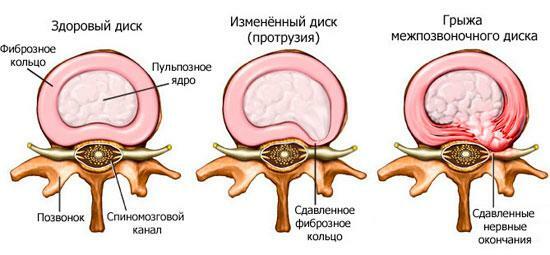
herniated lumbar spine: the treatment
material Content
- 1 Causes and symptoms
- 2 Drug therapy
- 3 Physiotherapy
- 4 Chiropractic
- 4.1 acupressure( acupressure)
- 4.2 Acupuncture( acupuncture)
- 5 physical exercises, swimming
- 6 Alternative Methods: hyperextension, respiratory gymnastics, pilates, yoga, hirudotherapy, apitherapy
- 6.1 Hyperextension
- 6.2 Respiratoryimnastika
- 6.3 gymnastics Strelnikova
- 6.4 Video - Breathing exercises Strelnikova
- 6.5 Pilates
- 6.6 Yogaterapiya
- 6.7 Hirudotherapy
- 6.8 Apiterapiya
- 6.9 Video - How to treat intervertebral hernia without surgery
- 7 Features Power hernia spine
- 8 Operational methods
Causes and Symptoms of the
Disease The lumbosacral section has to take on the largest, in comparison with other departments of the spine, the loadwhile walking, running, sitting. Therefore, this particular section of the spine is the most vulnerable and susceptible to the formation of hernias.
Common causes of the disease:
- osteochondrosis;
- increased stress on the spine;
- spine injury;
- hypodynamia( the consequence of a sedentary lifestyle);
- obesity;
- consequences of infectious diseases;
- disorders of posture( kyphosis, scoliosis);
- congenital malformations of the vertebrae.

The stages of formation of the intervertebral hernia
The first symptom of the development of the hernia is aching pain in the lumbar region. In the prone position, pain sensations disappear. This condition can last several years without causing serious discomfort. Ignoring the problem leads to the fact that, as a result of a gradual increase in the hernia in size, the pain becomes more intense and captures an increasing area: buttocks, hips, calves and even feet. To the pain are connected spasm of muscles and a marked restriction of mobility in the lower back.
Further development of the disease provokes the appearance of radicular syndrome, in which the spinal roots are compressed. As a result, the muscles of the lower extremities fall under the impact: thighs, shins, feet. The muscles weaken to such an extent that the patient can not jump, climb the steps, and later - and move independently. In this case, there is a violation of the sensitivity of the skin, numbness and tingling of the fingers, a sensation of goosebumps.
With the help of radiography, MRI or computed tomography of the lumbosacral department, the doctor will be able to make an accurate diagnosis and determine in which vertebra the problem is localized. After the delivery of all necessary tests and clarifying the diagnosis, the doctor will prescribe the appropriate treatment procedures in a particular case.

Schematic representation of the herniated disc
All herniated procedures are aimed at:
- pain relief;
- elimination of muscle spasm;
- improving blood circulation;
- mild spinal cord traction;
- recovery of spinal mobility.
Diverse methods of treating hernias are a huge amount. We suggest together to get acquainted with the most effective of them.
Medical therapy
Among the conservative methods of getting rid of hernia, the first place is taken by medication. Its goal is to relieve pain and inflammation, improve metabolic processes in tissues.

Preparation Meloxicam to relieve pain in the intervertebral hernia of the lumbosacral spine
For the treatment of the intervertebral hernia, the following preparations are used:
- , which reduce the intensity of pain and inflammation - Meloxicam , Diclofenac , Ibuprofen ;
- chondroprotectors working on hardening of cartilage tissue - Teraflex , Chondroxide ;
- angioprotectors, improving the function of blood flow - Actovegin ;
- anticonvulsants that stop neuropathic arising from damage to the peripheral nerve) pain - Lyrics , Neuralgin ;
- reducing muscular spasm - Xeomin , Midokalm .
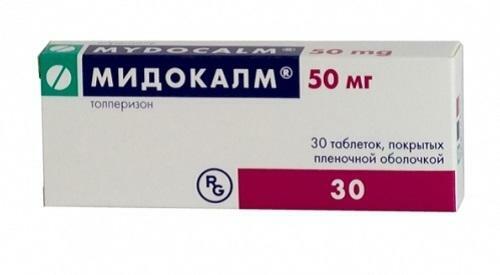
Meadocal medication to reduce muscular spasm
Of course, these drugs are prescribed only by a doctor, taking into account the individual characteristics of the patient.
Physiotherapy
When an acute pain syndrome is removed, you can proceed directly to eliminate the disease itself and restore normal functions of the spine. Among the medical recommendations, there is necessarily a place for physiotherapy, which has been used for the treatment of intervertebral hernias for the first decade and shows consistently positive results.
Physiotherapeutic rooms for the treatment of hernia use a standard set of procedures:
- exposure to galvanic current;
- electrophoresis;
- EHF( extremely high-frequency currents);
- magnetotherapy;
- acupuncture;
- paraffin treatment;
- ultrasound therapy( phonophoresis) and others.
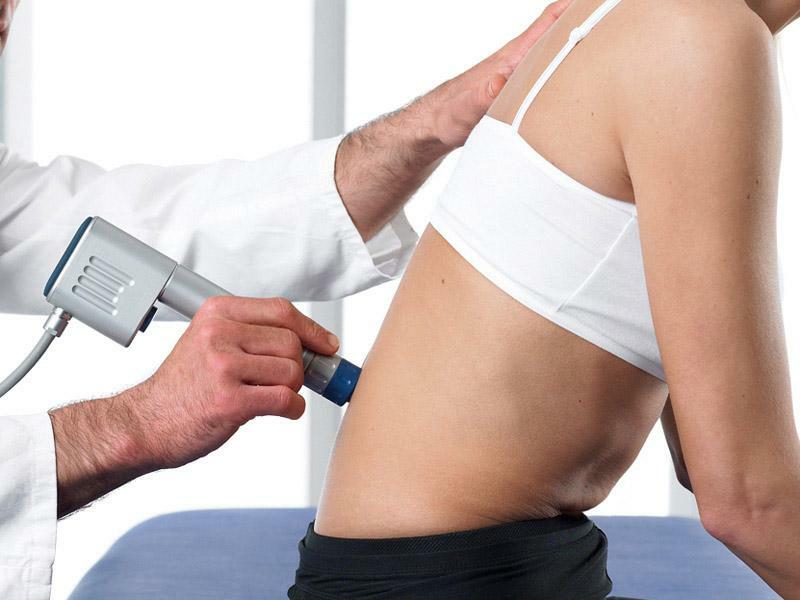
Ultrasound treatment of the intervertebral hernia of the lumbosacral spine
The main effects of physiotherapeutic procedures:
- decrease or complete removal of pain;
- preservation and improvement of muscle efficiency;
- strengthening of local and general immunity.
IMPORTANT! Each of the physiotherapy techniques has its own contraindications, so they can be used only according to the prescribing physician.
Manual therapy
The main method of manual therapy, used in the treatment of the intervertebral hernia in the lumbosacral department - therapeutic massage .Its task is to relax the strained muscles, improve local blood circulation and ease pressure on the damaged area. Massage can be not only manual, but also can.
IMPORTANT! To do therapeutic massage should be a specialist who is well versed in matters relating to the intervertebral hernia in the lumbosacral spine. Otherwise, massage can lead to worsening of the condition and aggravation of the disease.
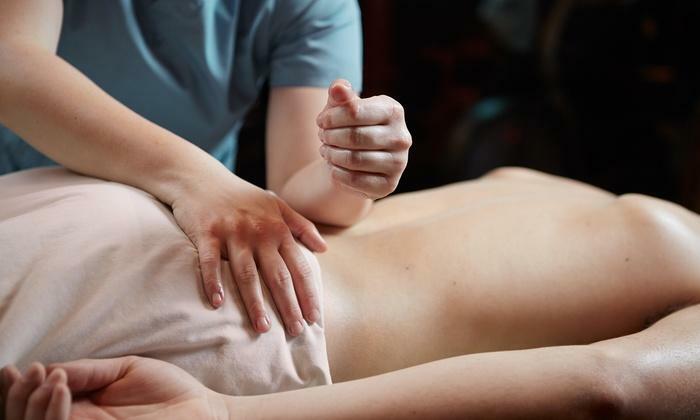
Manual therapy relaxes tense muscles, improves local blood circulation
The number of massage sessions necessary to relieve the condition is prescribed by the attending physician or masseur, depending on the degree of damage. Usually it takes 10-20 sessions to make a significant improvement.
Acupressure( Acupressure)
Auxiliary method in the treatment of hernia. The meaning of the technique is to activate the body's ability to self-repair by influencing certain points on the human body. This effect alone can not get rid of the intervertebral hernia, but it can strengthen the protective functions of the body and slightly reduce the pain.
Acupuncture( acupuncture)
Also affects biologically active points, but is more active. Special needles are introduced at different depths in the area of acupuncture points. Studying this ancient healing method, modern physiologists have discovered that, in fact, the needles enter bundles of nerve processes that, after such an active mechanical action, begin to work with increased yield.
Therefore, acupuncture is successfully used to treat most diseases known to science, including the intervertebral hernia. But this method is most effective for the removal of pain.
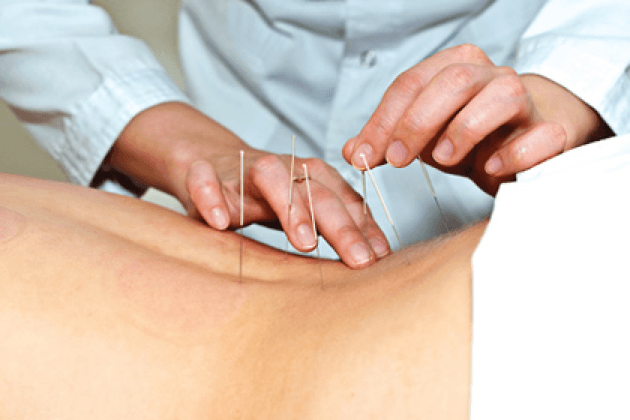
Acupuncture is successfully used to treat intervertebral hernia
Physical therapy, swimming
Among the basic procedures prescribed by a doctor with an intervertebral hernia, there is always exercise therapy with .The primary task of the exercise complex exercise with intervertebral hernia in the lumbosacral spine is a soft and natural stretching of the spine. And in combination with simultaneous stretching and strengthening of muscles and ligaments, this stretching gives a positive effect, gradually relieving hernia.
For the lumbar region there is a proven complex of therapeutic physical training, which has been practiced by doctors for many years. Usually the physician of the LFK individually selects the exercises for each patient, monitors the correctness of their implementation and corrects mistakes in a timely manner, therefore it is desirable to start practicing in the physicians' offices. Later you can limit yourself to doing exercises at home.

Complex of exercises with intervertebral hernia
Therapeutic physical training has its contraindications, which include:
- inflammatory processes in the acute stage;
- disorders of cerebral circulation;
- serious violations in the work of the cardiovascular system;
- thrombosis;
- oncology with metastases to the spine;
- ARVI, influenza and other conditions characterized by fever.
Swimming is the next tool for the speedy cure of the intervertebral hernia. In the process, the muscles relax, and the spinal column is stretched, reducing pressure on the affected area. Only to swim follows the rabbit or on the back to reduce the load on the waist. Swim preferably three times a week for an hour.
IMPORTANT! You can go swimming only in a state of remission. Swimming during the exacerbation of the hernia can further dislodge the intervertebral discs.
Alternative methods: hyperextension, respiratory gymnastics, pilates, yoga, hirudotherapy, apitherapy
In addition to the generally accepted and universally prescribed methods, there are some alternative options that can significantly accelerate recovery.
Hyperextension

Hyperextension is an effective exercise that develops and strengthens the rectifiers of the back
This is an effective exercise that develops and strengthens the back rectifiers, gluteus muscles and hip flexors. To perform the exercise, a special simulator called the "Roman chair" is used, which can be found in any fitness center. The value of the exercise consists in the simultaneous stretching and strengthening of the spine and muscles.
It is absolutely necessary to begin the training under the supervision and sensitive guidance of a competent instructor who is aware of the presence of a problem with the intervertebral hernia. He will help to put the correct technique of the exercise and avoid mistakes. You can do it two or three times a week.
Breathing exercises
Breathing exercises also help to effectively cope with hernias, although it requires considerable self-discipline. You can choose a suitable system for your own taste. The most effective in the hernia of the spine are Chinese qigong and Russian breathing exercises Strelnikova. Exercise exercises are easy enough to perform and are available for people with any level of physical fitness.
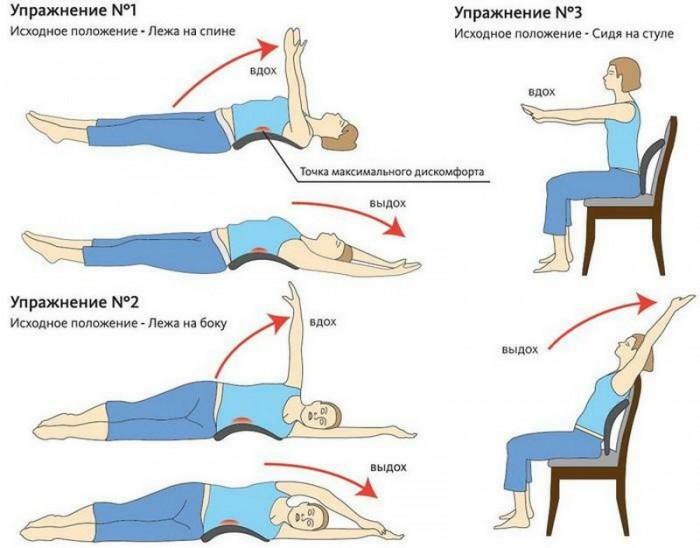
Gymnastics Strelnikova with intervertebral hernia
As a result, any respiratory gymnastics will bring:
- flexibility of the spine and joints, improving their mobility;
- improved blood supply;
- posture correction;
- removal of muscle spasms;
- elimination of infringements of nerve roots;
- relief from pain;
- general improvement of well-being and health improvement of the body.
The Qigong exercise complex aims to consciously and consistently relax the muscles in each part of the body. All movements are carried out very slowly - so that the breathing remains deep and calm, and the heart rate does not become more frequent.
Strict contraindications to Qigong gymnastics are only three:
- exacerbation of hypertension;
- bleeding;
- schizophrenia.

Qigong exercises for beginners
With care to carry out the exercises and is in the presence of diseases of the circulatory system, serious heart diseases, malignant tumors.
IMPORTANT! Qigong classes require compulsory work with an instructor, at least initially. Self-mastery of gymnastics can lead to unpredictable results due to violation of the technique of performing exercises.
You can practice two or three times a week for a long time( optional).
Gymnastics Strelnikova
Strelnikova Gymnasium, originally created to restore the vocal cords of singers and actors, has been successfully used for several decades to rid the spine, including the intervertebral hernia. Intensive breathing through the nose during the execution of the complex of exercises promotes the use of the entire volume of the lungs. Once at the maximum depth( in the region of the waist), the air drives the muscles and slightly stretches the spine, which is necessary to get rid of the hernia.
Especially effective for the rehabilitation of the musculoskeletal system of the exercise of an auxiliary complex. The only contraindication to the performance of the entire complex of gymnastics is the presence of bleeding.
IMPORTANT! Some exercises of respiratory gymnastics Strelnikova are contraindicated in hernia in the lumbosacral section. These include "Bokovushki", "Scales with slope", "Circular movements of the body".
Having chosen suitable exercises, it is necessary to engage in daily mornings and evenings( twice a day) for 7-14 days. Then you can reduce the number of classes to one per day( time is not important).As the condition improves, you can reduce the number of classes per week, bringing up to two or three.
Video - Respiratory gymnastics Strelnikova
Pilates
Pilates is one of the best techniques for the speediest disposal of the intervertebral hernia. Classes are aimed at gradual and gentle restoration of the anatomically correct position of intervertebral discs relative to each other. As a result, spasm of muscles, jamming of blood vessels and nerve roots is eliminated. Reducing the load on the lower back is achieved with the help of the technique of pelvic tension.
Since Pilates is a gentle healing method, its only contraindications are severe pain in the affected area and an acute stage of the disease. Pilates can be practiced daily one or two times over many months. There are no restrictions.
Pilates exercise complex
Yoga therapy
Yoga therapy - practice of classical asanas. To get rid of the intervertebral hernia, Iyengar yoga is most suitable, which has the maximum health-improving effect on the musculoskeletal system. The main rules during hernia training are avoiding excessive workloads and eliminating asanas that cause discomfort or pain.
IMPORTANT! You should start practicing yoga with an instructor who will help you choose the appropriate exercises and check the correctness of their performance.
Yoga classes have many contraindications that can not be ignored:
- craniocerebral trauma;
- spine trauma;
- malignant tumors;
- affection of joints of an infectious nature( reactive arthritis);
- hernia in the groin;
- severe heart disease;
- hypertension;
- increased intracranial pressure;
- mental illness;
- pregnancy in the second and third trimester;
- ARVI and other diseases with fever and fever.
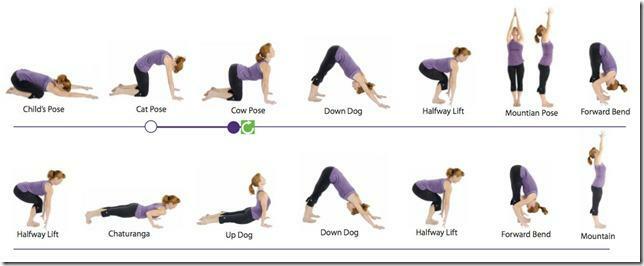
Yoga complex for beginners
If contraindications are not available, you can practice for half an hour daily. Gradually, the yogi will harmoniously fit into everyday life. It is also possible to practice yoga periodically( for example, a couple of times a week).
Hirudotherapy
Hirudotherapy - treatment of the intervertebral hernia with the help of leeches. Biting the human skin, the leech not only sucks the stagnant blood, but also injects hirudin in its place, which is a unique and useful composition containing about 100 biologically active substances.

What is hirudotherapy
The main positive effects of the method:
- removal of pain and swelling;
- improvement of blood microcirculation in damaged tissues;
- elimination of muscle spasms;
- stimulation of the regeneration process;
- elimination of the inflammatory process;
- activation of local and general immunity.
Leeches( 4-6 pieces) are placed in the lumbosacral spine at a distance of 3-5 cm from the spine on both sides. The action of the leech is enhanced by installing it on special active points. When the leech is saturated with blood, it is detached itself( usually in 40-60 minutes).You can conduct sessions every three days. After 10 sessions, you need to take a break for at least two months.
IMPORTANT! For treatment only special medical leeches are used. The use of non-scheduled river leeches may lead to inflammatory processes.
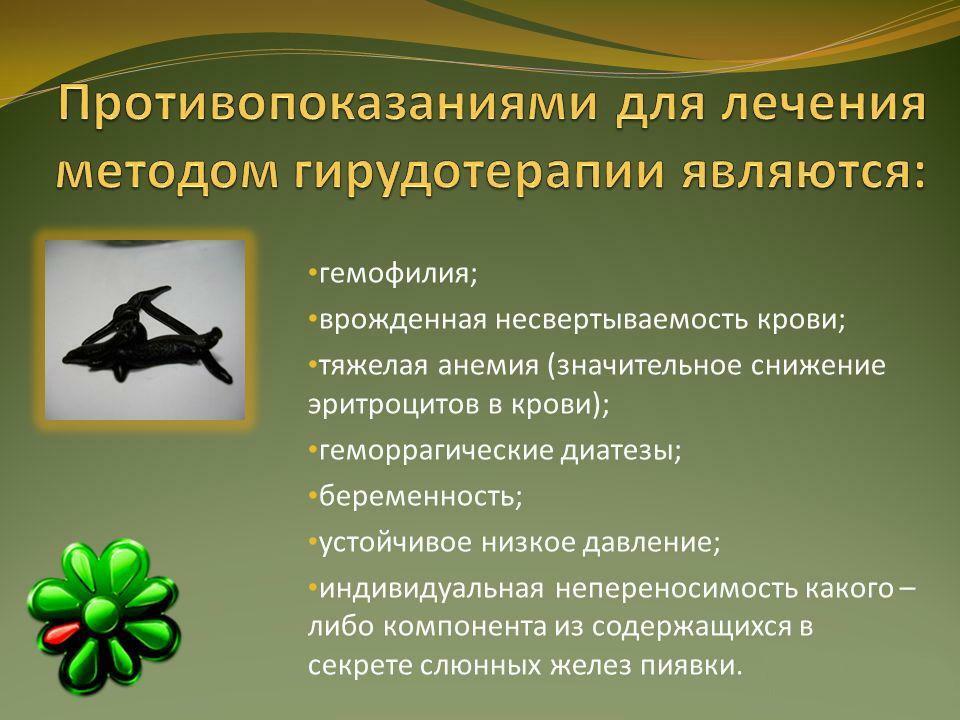
Contraindications of hirudotherapy
Before starting treatment, it is necessary to make a biological test by placing one leech in the lumbar region. If after a day there were no allergic reactions, the method can be used.
Apitherapy
Apitherapy is the treatment of hernia by bees. The method combines the healing effect of bee venom with reflexotherapy( acupuncture), as bees, like leeches, are placed on biologically active points of the human body.
Bee venom containing apitoxin, brings great benefits to the body:
- improves blood circulation;
- relieves inflammation and pain;
- promotes relaxation of spasms;
- reduces tissue swelling;
- reduces the compression of the nerve roots;
- stimulates the production of anti-inflammatory hormones by the body.
Bee during the session can be seated on both biologically active points, and on the most painful areas. It is necessary to start with two or three bees, increasing their number with each session, gradually bringing up to 15-20.You can go through 10-20 sessions. If necessary, repeat the course is permissible after six months.
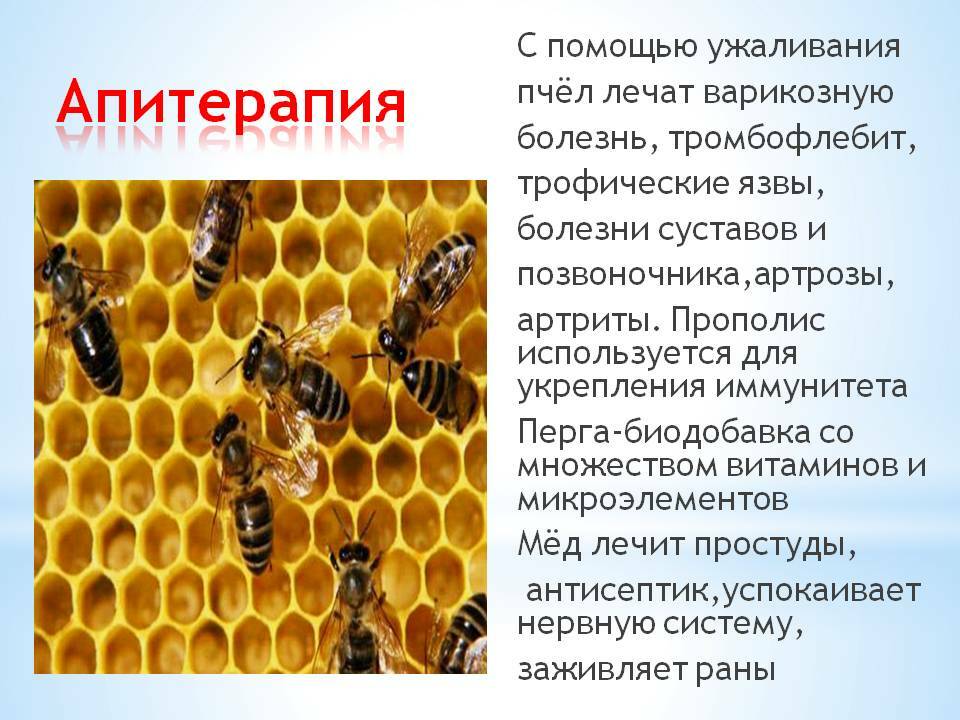
Use of Apitherapy
IMPORTANT! Bee venom can cause intense allergic reactions, so preliminary holding of at least one biological test is mandatory. To do this, one bee is placed on the lower part of the forearm, after a sting, the stinger is left in the skin for 10 seconds. If there are no allergic reactions within 24 hours, the method can be used.
Summary table of alternative treatments for hernia of the lumbosacral
| Method | Number and duration of sessions / procedures |
|---|---|
| Hyperextension | Two or three sessions per week. It is permissible and even desirable to continue the classes and after getting rid of the hernia in order to maintain the effect |
| Qigong gymnastics | Two or three sessions per week throughout life( without restrictions) |
| Respiratory gymnastics Strelnikova | For 7-14 days in a row,evening. Later you can leave one lesson per day two or three times a week |
| Pilates | There are no strict limitations. You can practice daily one or two times for a long time( at will) |
| Yoga | Daily for half an hour. After getting rid of a hernia, the exercises can be left in the same schedule or cut to two or three times per week |
| Hirudotherapy | 10 sessions every three days. You can repeat the course two months later |
| Apitherapy | 10-20 sessions every other day. You can repeat the course every 6 months |
IMPORTANT! Before using any of the above methods, consultation with a doctor is strictly required!
Video - How to treat an intervertebral hernia without surgery
Features of nutrition for a hernia of the spine
To facilitate the condition, supplement treatment, accelerate recovery, it is necessary to think about the correct diet that helps to restore intervertebral discs. Often, problems with the spine are caused by inaccuracies in the diet, depriving the body of substances that are so necessary to it. So, for the spine condition is harmful:
- salt surplus;
- an abundance of sweet food, buttery pastries;
- canned food;
- alcohol;
- drinks containing caffeine.
These products suppress immunity, increase inflammation, negatively affect the circulation, destroy cartilage tissue. From such food in the presence of an intervertebral hernia it is necessary to refuse.
But, in contrast, there are a number of substances useful for the spine. They must be included in the daily diet during the treatment of hernia and for its prevention. Such substances include:
- vitamin C;
- vitamin D;
- arginine;
- mucopolysaccharides;
- gelatin;
- Omega-3 fatty acids;

Products enriched with vitamins
Vitamin C is endowed with antioxidant properties that help to restore body resources and remove slags accumulated as a result of the pathological process in the spine. Contains this vitamin in black currant, sea-buckthorn, citrus, greens.
Calciferol vitamin D is involved in the formation and strengthening of bone tissue. Sources of vitamin D - egg yolk, sea fish and fish liver, sour-milk products, oat flakes.
Arginine, getting into the body, helps to relax the muscles and relieve spasms, and also actively participates in the formation of muscle tissue. It is in sufficient quantity contained in nuts, pumpkin and sesame seeds, red fish.
Mucopolysaccharides, which build up cartilage tissue, are mainly found in fish.
Gelatin is found in the cartilaginous tissue of animals, so it is useful to include in the diet a cold, cartilage from soup bones.
Omega-3 fatty acids help the vertebrae maintain mobility and repair cartilage tissue. Organism Omega-3 can be obtained from flax and sesame seeds, fish, olive and linseed oil, beans.
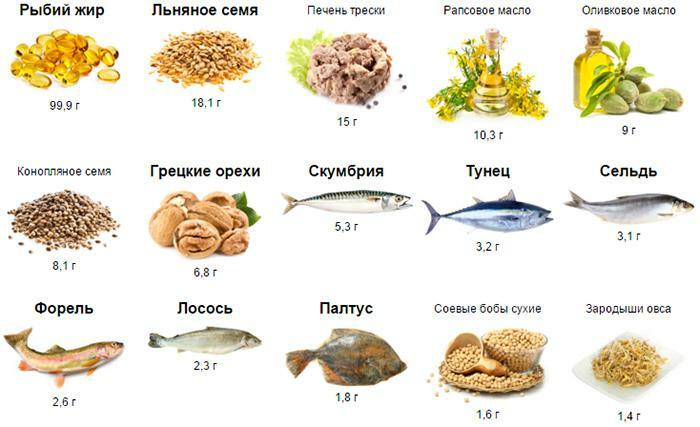
Foods High in Omega-3 Acids
IMPORTANT! During treatment, an additional intake of the substances listed above in the form of additives may be necessary.
Attention should also be paid to drinking regimen, as the fluid occupies a significant percentage of the intervertebral cartilage. Therefore, the notorious two liters of water per day should not be discarded.
Operative methods
Surgical intervention is an extreme measure used in advanced cases of the intervertebral hernia, when it is not possible to achieve lasting improvement by conservative methods. The operation is prescribed and performed in rare cases, if other procedures do not have any effect for six weeks.
The main argument against - possible complications after surgery, which include:
- infection;
- formation of hematomas, provoking compression of the nerve roots;
- damage to nerves and muscles;
- formation of unaesthetic scars as a result of a large incision;
- a long and painful rehabilitation period.
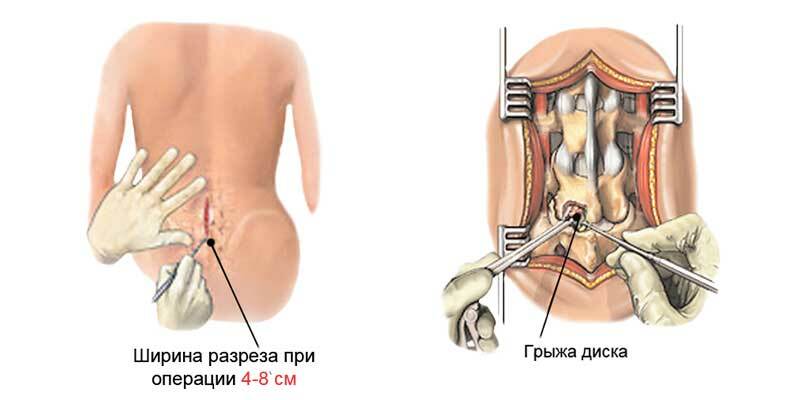
Surgery for the removal of a herniated lumbosacral
For the removal of a herniated lumbosacral spine, methods are used:
- endoscopic discectomy;
- microdiscectomy;
- Laminectomy.
The most modern and safe method is microdiscectomy. This is the most gentle operation on the lumbosacral spine, in which the damaged intervertebral disc is removed through a small neat incision. The risk of complications with such intervention is minimized, and the scar turns out to be miniature. Most patients who underwent microdiscectomy notice significant improvements after only a couple of weeks.
Persistent positive results in the treatment of the intervertebral hernia of the lumbosacral can only be achieved through an integrated approach. The combination of several techniques will help in a short time to restore the health of the musculoskeletal system.



